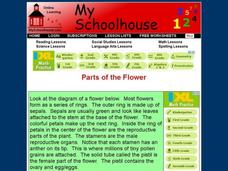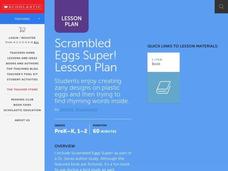EngageNY
End of Unit Assessment Parts 1 and 2: Evaluating Arguments and Claims
Which came first: the chicken or the egg? As part of the end-of-unit assessment for The Omnivore’s Dilemma, scholars watch a video about organic eggs versus conventional farm eggs. They use graphic organizers to collect evidence as they...
Curated OER
Osmosis and the Cell Membrane-part 2
Students participate in a review of diffusion and the basic properties of the cell membrane before exploring the process of osmosis in a lab activity. Using shell-less eggs that have soaked in various solutions, students make...
Curated OER
What Came First, the Chicken or the Egg?
Students explore the concept of nutrition. In this nutrition instructional activity, students identify the benefit of eggs as a nutritional meal or snack. Students also discover how to prepare easy meals or snacks using...
Curated OER
Parts of the Flower
In this biology activity, students examine a diagram of a flower and read a selection that describes all of the parts including the petals, the stamen, the anther, and the sepals. They answer 11 on-line fill in the blank questions using...
Curated OER
Meat, Poultry, Fish, Eggs: Constructing and Maintaining
Students investigate meat as a source that provides protein, iron and nutrients in the diet. They identify types of meat and their sources, complete a market survey, conduct a fried egg experiment, and prepare various recipes that...
Curated OER
Parts of Speech- Worksheet 1
In this grammar worksheet, students identify the underlined words in twenty sentences as one of the following parts of speech: noun, verb, adverb, adjective, pronoun, conjunction or preposition.
Curated OER
Stomping and Romping with Shakespeare
Did you know that Green Eggs and Ham is written in iambic pentameter? Model the rhythm of language using Dr. Seuss’s tale. Direct class members to march about the room tapping their right foot on the first syllable and stomping their...
Virginia Department of Education
Meiosis
Intrigue the class by completing a lesson on meiosis, filled with challenging and insightful activities to spark the interest of every person in the room. Each member of the class learns about genetic disorders due to faulty meiosis, and...
Curated OER
The Purpose of Each Part of a Plant
Beginning botanists can sketch the parts of a plant in individual boxes, or better yet, they can tape or glue actual plant parts in them. Beside each box are a few sentences with selected words left out. From the word bank at the bottom...
Curated OER
Parts of a Chicken
In this chicken anatomy worksheet, students color and label 11 major parts of a chicken. There is a word bank to assist students.
Curated OER
Scrambled Eggs Super!
Students study rhythm and rhyme. In this rhyming lesson, students read Scrambled Eggs Super! by Dr. Seuss. Students explore the rhythm of rhyming words found in the book. The students decorate eggs and place rhyming words inside to use...
PBS
The Butterfly or Adult
Now that your class knows about the life cycle of a butterfly, it's time to discuss how an adult butterfly survives in the wild. The class diagrams and labels the parts of a butterfly, discusses how butterflies survive, and then make a...
American Chemical Society
Chemical Reactions and Engineering Design
Construction leads to habitat loss and local wildlife suffers. Scholars must build a reptile egg incubation device that meets many constraints. Various experiments help them discover the chemical reaction needed to reach...
Virginia Department of Education
Cell Parts
What do a bird, an egg, a rabbit, and a toad all have in common? This fun-filled resource explains the similarities and differences between cells and how all cells are similar, yet all are different. Learners begin by depicting a...
Curated OER
Part of a Whole Group One
For this fractions worksheet, students solve word problems where they solve problems about parts of whole groups using pictures, charts, and more. Students complete 4 problems.
Curated OER
Egg-ceptional Poetry Writing
Young scholars recognize that eggs have nutritional value. In this eggs instructional activity, students create poetry for a shape book on eggs. Young scholars participate in additional games and activities about the egg.
Curated OER
Naked Egg Drop
In this science project worksheet, students create a container that catches a raw egg and prevents it from breaking. They measure that the container is under 19.5 inches in width and length. Students also calculate their scores from the...
Curated OER
Eggs
Students know the following parts of an egg as the yolk, white, shell, membrane, chalaza, and air sac. They also sequence the growth of the chick in the egg. An egg is broken and students touch, smell and see it. They locate the six...
Curated OER
Eggs: A Practical Application
Apply food selection and preparation guidelines related to egg products. National Standard 14.3.3 Identify functions of eggs: binder, thickener, coating, leavening agent, emulsifier Identify egg cooking temperatures, techniques/methods:...
Curated OER
Flower Structure and Reproduction
In this plant science worksheet, students color and label the different parts of the flower. They write short answers to 14 questions about flowers.
Curated OER
Hatching Chickens
Students observe chicks hatching from eggs. In this science lesson, students view a video to develop an understanding of the proper care and needs of eggs and live animals. This is a great precursor activity for hatching eggs in class.
Curated OER
Which Egg Is Fertile?
In this egg worksheet, learners analyze 2 picture of eggs and determine which egg is fertile. They then write an explanation of why they chose that egg.
Curated OER
The Classroom Easter Egg Hunt
Students work cooperatively to discover hidden Easter eggs in the classroom using prepositions of location. They record the location of the eggs on the worksheet found at the included web link but do not move it so others can find it.
Curated OER
Young Writer's Worksheet- Writing Prompt- Decorating Easter Eggs
In this young writer's workshop worksheet, students write an open response to the prompt, "Edgar liked to decorate eggs. His favorite part was..." They see a picture of an Easter rabbit using various colors to decorate eggs at the top of...























